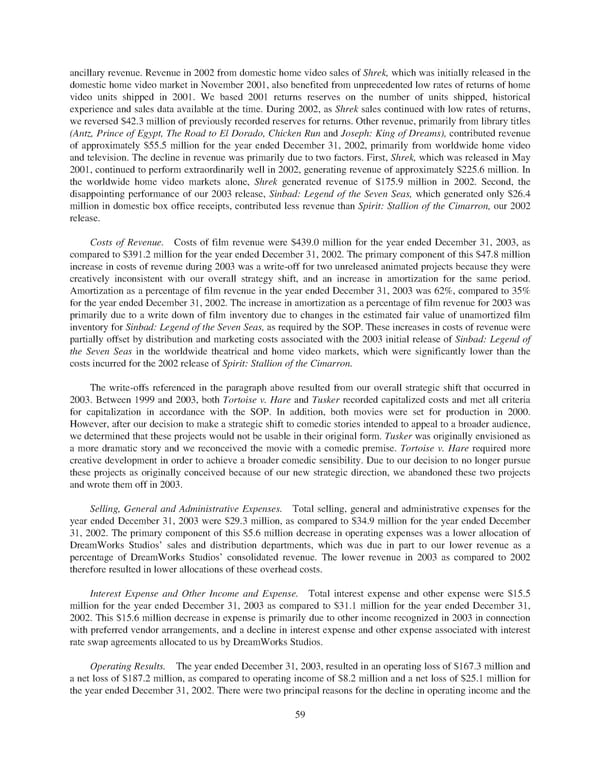ancillary revenue. Revenue in 2002 from domestic home video sales of Shrek, which was initially released in the domestic home video market in November 2001, also benefited from unprecedented low rates of returns of home video units shipped in 2001. We based 2001 returns reserves on the number of units shipped, historical experience and sales data available at the time. During 2002, as Shrek sales continued with low rates of returns, wereversed $42.3 million of previously recorded reserves for returns. Other revenue, primarily from library titles (Antz, Prince of Egypt, The Road to El Dorado, Chicken Run and Joseph: King of Dreams), contributed revenue of approximately $55.5 million for the year ended December 31, 2002, primarily from worldwide home video and television. The decline in revenue was primarily due to two factors. First, Shrek, which was released in May 2001, continued to perform extraordinarily well in 2002, generating revenue of approximately $225.6 million. In the worldwide home video markets alone, Shrek generated revenue of $175.9 million in 2002. Second, the disappointing performance of our 2003 release, Sinbad: Legend of the Seven Seas, which generated only $26.4 million in domestic box office receipts, contributed less revenue than Spirit: Stallion of the Cimarron, our 2002 release. Costs of Revenue. Costs of film revenue were $439.0 million for the year ended December 31, 2003, as compared to $391.2 million for the year ended December 31, 2002. The primary component of this $47.8 million increase in costs of revenue during 2003 was a write-off for two unreleased animated projects because they were creatively inconsistent with our overall strategy shift, and an increase in amortization for the same period. Amortization as a percentage of film revenue in the year ended December 31, 2003 was 62%, compared to 35% for the year ended December 31, 2002. The increase in amortization as a percentage of film revenue for 2003 was primarily due to a write down of film inventory due to changes in the estimated fair value of unamortized film inventory for Sinbad: Legend of the Seven Seas, as required by the SOP. These increases in costs of revenue were partially offset by distribution and marketing costs associated with the 2003 initial release of Sinbad: Legend of the Seven Seas in the worldwide theatrical and home video markets, which were significantly lower than the costs incurred for the 2002 release of Spirit: Stallion of the Cimarron. The write-offs referenced in the paragraph above resulted from our overall strategic shift that occurred in 2003. Between 1999 and 2003, both Tortoise v. Hare and Tusker recorded capitalized costs and met all criteria for capitalization in accordance with the SOP. In addition, both movies were set for production in 2000. However, after our decision to make a strategic shift to comedic stories intended to appeal to a broader audience, wedetermined that these projects would not be usable in their original form. Tusker was originally envisioned as a more dramatic story and we reconceived the movie with a comedic premise. Tortoise v. Hare required more creative development in order to achieve a broader comedic sensibility. Due to our decision to no longer pursue these projects as originally conceived because of our new strategic direction, we abandoned these two projects and wrote them off in 2003. Selling, General and Administrative Expenses. Total selling, general and administrative expenses for the year ended December 31, 2003 were $29.3 million, as compared to $34.9 million for the year ended December 31, 2002. The primary component of this $5.6 million decrease in operating expenses was a lower allocation of DreamWorks Studios’ sales and distribution departments, which was due in part to our lower revenue as a percentage of DreamWorks Studios’ consolidated revenue. The lower revenue in 2003 as compared to 2002 therefore resulted in lower allocations of these overhead costs. Interest Expense and Other Income and Expense. Total interest expense and other expense were $15.5 million for the year ended December 31, 2003 as compared to $31.1 million for the year ended December 31, 2002. This $15.6 million decrease in expense is primarily due to other income recognized in 2003 in connection with preferred vendor arrangements, and a decline in interest expense and other expense associated with interest rate swap agreements allocated to us by DreamWorks Studios. Operating Results. The year ended December 31, 2003, resulted in an operating loss of $167.3 million and a net loss of $187.2 million, as compared to operating income of $8.2 million and a net loss of $25.1 million for the year ended December 31, 2002. There were two principal reasons for the decline in operating income and the 59
 DreamWorks Annual Report Page 64 Page 66
DreamWorks Annual Report Page 64 Page 66